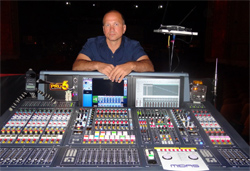Last year’s tour package of Blondie and Devo filled theaters across the U.S., with New Hampshire-based RPM Dynamics putting together the touring control system, including a Midas PRO6 at front of house a PRO2C for monitors.
RPM Productions principal Jim Roese designed the control package, built the racks and hit the road with the tour as production manager and monitor engineer for Blondie.
“The main reason we chose Midas is obviously the sound of the consoles,” he says. “That was important for this tour, because every show was being archived via multitrack, and everyone in Blondie is on in-ears. For monitors, the PRO2C also has incredibly fast navigation.”
Joining Roese on the “Whip It To Shreds” tour were FOH engineers Rod Nielsen (Blondie) and Paul David Hager (Devo), along with Devo monitor engineer Adam Beck-Slaten. All were touring with the Midas PRO Series for the first time.
“You start with the sound of it, obviously,” says Hager of the PRO6. “I was a Midas analog guy for decades, and sonically, this feels like an XL4. Some of the features are pretty cool, like the POP Groups, and having 10 VCAs is nice. It’s a different workflow than the console I’ve been using the past eight years, but it only took me a day or so to feel it out. I remember how alien it felt when I first went digital, and I had a little of that same feeling again with the PRO6. It was like a déjà vu, but with much better sound.”
Another Midas feature that was a big hit with Hager was the system’s latency management system, which allowed him to seamlessly insert his preferred effects rack. Adding a Midas DL451 Modular I/O box to the rack enabled him to connect up to 24 streams of analog and digital signals via one Cat5 cable connected to one of the AES50 ports on the PRO6 surface.
“To do a proper Devo show, certain effects and devices are required,” he explains. “I was very impressed with the system’s ability to handle all that external processing automatically, without any hint of phasing or timing issues – something I’m always very aware of. In my opinion, the latency management system is one of the big reasons the console sounds so great.”
Midas channel grouping eliminates layers, using VCAs and POPulation Groups to make navigation faster and more intuitive for the engineer.
“Once you’ve got your show set up, you’re really not looking at individual channels anymore,” says Blondie FOH mixer Rod Nielsen. “There’s no need. I mix primarily through VCAs, with POP Groups for things I don’t want necessarily coupled together as VCAs. I also use Area B, mostly for Debbie Harry’s vocals and spares. It’s also great for playback. At the head of the show, I’ve got that playback on my right hand before Debbie comes out. Very convenient.”
Devo monitor engineer Adam Beck-Slaten made the adjustment to the PRO2C with relative ease. “When I first looked at the console, I thought it was too small, but with the POP Groups and VCAs, I’m able to navigate real fast on it. And it sounds so good! Just firing it up and raising the faders tells you all you need to know. It’s going to be on my rider after this.”
Roese also likes the flexibility of the Midas PRO Series. “One of the nice features of the Midas is that you can route anything, anywhere,” he says. “I put all of Debbie’s vocal mics into one matrix, then route that feed into two channels, one of which is compressed and the other one not. The uncompressed feed goes to Debbie’s ears, the comped version goes to everyone else. Doing that, when I need to make a microphone change, all I have to do is unmute the mic I want and all of my ear mixes follow, which is really slick.”
Another key element of the Midas digital platform is its 96k, 24-bit AES50 datastream, which allows the system’s pristine sound to be ported to other uses, such as outboard software suites and multitrack recording. On the Blondie/Devo tour, each show was archived for future use via the new RPM-TB48, which integrates a pair of 24-channel Lynx Studio Technology AES16e-50 PCIe cards within a customized Sonnet Thunderbolt box to create a 48-channel turnkey recording solution. The system was developed by Jim Roese, working directly with Lynx, Midas, and Sonnet to develop it into a seamless, integrated system.
“The RPM-TB48 is something I’m pretty proud of. It’s actually a product now, and anyone can buy it through RPM Dynamics,” says Roese. “Since AES50 is native on Midas desks, there’s no need for MADI cards or other hardware, so it’s much more affordable than other protocols. The RPM-TB48 is a simple, user-friendly, turnkey system that now fills the void Midas users have been requesting for years. We used it to record every show on the tour, all at 96k with those lovely XL4 preamps. You can also use it to run plug-in suites like Waves, which is a great capability to add to a Midas console.”




















